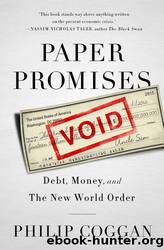Paper Promises: Debt, Money, and the New World Order by Philip Coggan

Author:Philip Coggan [Coggan, Philip]
Language: eng
Format: epub
ISBN: 9781610391276
Google: wqg4DgAAQBAJ
Published: 2012-01-17T18:55:59.274000+00:00
Figure 2. Foreign exchange reserves (minus gold)
Source: International Financial Statistics Database
This initially resulted in inflation, as any economist might have predicted. In the US consumer prices rose more than fivefold between 1971 and 2010; in Britain, the increase was tenfold. The effect was fastest in the 1970s, when US prices more than doubled and in Britain they increased more than threefold. After that, central banks managed to get a handle on inflation. The period after 1982 has been described by economists as the âgreat moderationâ because economic growth was steady and recessions rare while inflation was generally low, except for a brief period at the end of the 1980s.
The great moderation was accompanied by an extraordinary boom in asset markets. Share prices had really suffered in the 1970s, under pressure from double digit inflation and falling output; the real value of US share prices fell by 42 per cent between 1972 and 1982, according to Barclays Capital. In Britain, share prices fell by 31 per cent in real terms in 1973 and by a further 55 per cent in 1974. In 1979, the cover of Business Week proclaimed âThe Death of Equitiesâ.
But share prices are nearly always at their most attractive when sentiment is weakest. In 1982, the Dow Jones Industrial Average was no higher than it had been in 1965, even though economic activity was much greater. Shares offered a dividend yield of 6 per cent, as high as it had been in the depths of the Great Depression or during the Second World War. The price â earnings ratio (the relationship of the share price to current profits) was in single digits. The market was like a Labrador dog after an hour in the car, bursting to run wild. Not only did profits boom but valuations soared: moving from a 6 per cent dividend yield to a 3 per cent yield means a doubling in price, even if dividends remain unchanged. By the middle of 1987, the Dow had risen almost threefold from the low.
What followed was, in retrospect, the defining moment of the bubble era. On 19 October 1987, the Dow fell by almost 23 per cent in one day (Black Monday as it became known). Share prices round the world followed suit, from London to Hong Kong. No economic or political event seemed to be to blame. At the time, it seemed eerily reminiscent of the crash of 1929, the event popularly assumed to have ushered in the Great Depression.
Central banks, led by Alan Greenspan, the chairman of the US Federal Reserve, resolved to head off this calamity. They vowed to lend money to any bank or broker who had been caught out by this sudden plunge in prices. And they cut interest rates in order to encourage spending, discourage saving and make owning shares look more attractive than holding cash.
Investors learned an important lesson from this crisis. If asset markets fell far and fast enough, central banks would ride to the rescue. In a sense, the central banks had insured investors against enormous losses.
Download
This site does not store any files on its server. We only index and link to content provided by other sites. Please contact the content providers to delete copyright contents if any and email us, we'll remove relevant links or contents immediately.
Zero to IPO: Over $1 Trillion of Actionable Advice from the World's Most Successful Entrepreneurs by Frederic Kerrest(4303)
Machine Learning at Scale with H2O by Gregory Keys | David Whiting(4192)
Never by Ken Follett(3799)
Harry Potter and the Goblet Of Fire by J.K. Rowling(3776)
Ogilvy on Advertising by David Ogilvy(3516)
Shadow of Night by Deborah Harkness(3307)
The Man Who Died Twice by Richard Osman(2998)
Book of Life by Deborah Harkness(2869)
The Tipping Point by Malcolm Gladwell(2829)
Will by Will Smith(2795)
0041152001443424520 .pdf by Unknown(2785)
My Brilliant Friend by Elena Ferrante(2776)
How Proust Can Change Your Life by Alain De Botton(2746)
Purple Hibiscus by Chimamanda Ngozi Adichie(2653)
How to Pay Zero Taxes, 2018 by Jeff A. Schnepper(2602)
Hooked: A Dark, Contemporary Romance (Never After Series) by Emily McIntire(2502)
Rationality by Steven Pinker(2291)
Borders by unknow(2232)
Can't Hurt Me: Master Your Mind and Defy the Odds - Clean Edition by David Goggins(2230)
